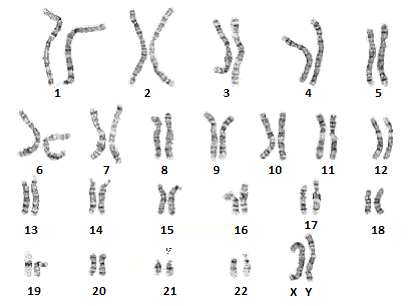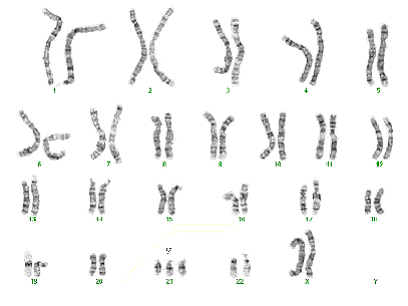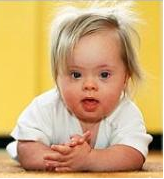Down's Syndrome- Trisomy 21
Down's syndrome is a genetic or chromosomal disorder in which an individual has 3 chromosomes in the 21th set of autosomes, instead of the normal amount of 2 chromosomes.
In human beings, a normal, healthy individual has 22 pairs of autosomes and one pair of sex chromosomes. Each pair out of these 23 sets (again, in a normal individual) consists of 2 chromosomes, for a total amount of 46 chromosomes.
However, an individual with down's syndrome has an extra chromosome in the 21th set of autosomes,
so, in total, has 47 chromosome. An individual
with patau's syndrome can be male or female. Being that an individual has an extra chromosome in one of its set,
this is an abnormality and leads to developmental issues such as varying degrees of mental retardation, moon
face, pseudoepicanthic fold, larger than normal, sometimes furrowed tongue, and larger than normal hands with
stubby fingers;
all these issues will be
explained and talked in more in-depth below.
Chromosomes of a Normal Healthy Individual
To show the contrast between a normal individual who has 23 pairs of chromosomes for a total of 46 chromosomes and an individual with down's syndrome who has 47 chromosomes, we will look at the karyotype of both individuals, which shows the profile of each's chromosomes.
Below is the karyotype of a normal and healthy male individual:

You can see the 21th set, as they are numbered above, with 2 chromsomes. This is the amount of chromosomes that a normal individual has who has no irregularities in
genetic make-up.
Down's Syndrome- Trisomy 21
However, a few individuals are born not with 2 chromosomes in their 21th set, but with 3 chromosomes. They are individuals with an extra chromosome in their 21th autosome set.
This is the reason why down's syndrome is referred to also as trisomy 21. Because in the 21th set, there are 3 (tri) chromosomes.
Below is the karyotype of an individual with down's syndrome:

You can see the extra chromosome present in the 21th set of autosomes.
Symptoms of Down's Syndrome
The symptoms that result from an individual who has down's syndrome are varying degrees of mental retardation, moon face, pseudoepicanthic fold, larger than normal, sometimes furrowed tongue, and larger than normal hands with stubby fingers.
- Varying Degrees of Mental Retardation- Individuals who have down's syndrome have mental retardation to varying degrees; some may only have slight learning disabilities, while others may have more difficulty.
- Moon face- This is a medical term for a person who has a large chin and forehead, resulting in a moon shape, when looked at from the side. People with down's syndrome may have this condition.
- Pseduoepicanthic fold- This is a fold of skin of the upper eyelid that partially covers the inner corner of the eye.
- Larger than normal, sometimes furrowed tongue- This is a tongue marked by numerous longitudinal grooves on the surface.
- Larger than normal hand with stubby fingers- An individual with down's syndrome may have big hands with fat, stubby fingers.
Below is a picture of an infant with down's syndrome:

You can see how this baby has somewhat fat, stubby hands and fingers. You can also see how his chin is somewhat oblong.
Incidence of Down's Syndrome
The incidence of individuals having down's syndrome is 1 out of 800 live births. Children being born with down's syndrome are more likely as the age of the mother increases. Take these statistics. There is a 1 in 1500 chance of a woman in her early 20s giving birth to a child with down's syndrome. There is a 1 in 80 chance of woman in her early 40s giving birth to a child with down's syndrome. And there is a 1 in 44 chance of a woman in her late 40s giving birth to a child with down's syndrome.
For this reason of incidence, it's best for a woman to have children as early on in her life as she
can, to prevent complications such as these.
References
http://en.wikipedia.org/wiki/Moon_face
Related Resources
Edward's Syndrome
Patau's Syndrome
Turner's Syndrome
Klinefelter's Syndrome
Supermale- XYY Syndrome
Superfemale- XXX Syndrome
